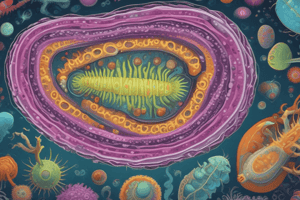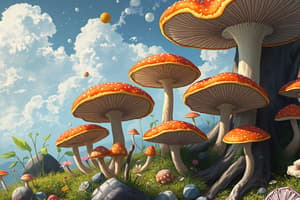Podcast
Questions and Answers
How are protists classified?
How are protists classified?
Protists are often classified by characteristics that resemble those of fungi, plants, and animals.
What are the general characteristics of Kingdom Protista?
What are the general characteristics of Kingdom Protista?
Most are microscopic, single-celled or simple multicellular eukaryotic organisms, containing mitochondria and sometimes chloroplasts.
What are the 3 different types of protists?
What are the 3 different types of protists?
Animal-like protists, plant-like protists, fungus-like protists.
What are animal-like protists?
What are animal-like protists?
What are plant-like protists?
What are plant-like protists?
What are the pros of protists?
What are the pros of protists?
What are the cons of protists?
What are the cons of protists?
How do scientists classify organisms?
How do scientists classify organisms?
Why is classification important?
Why is classification important?
What are the different types of classification?
What are the different types of classification?
What are the names of 3 phylums and 1 group in protists?
What are the names of 3 phylums and 1 group in protists?
What is the role/importance of fungi in ecosystems?
What is the role/importance of fungi in ecosystems?
What happened when mushrooms were placed on soil contaminated with oil?
What happened when mushrooms were placed on soil contaminated with oil?
How have mushrooms been used as filtration systems?
How have mushrooms been used as filtration systems?
How could filtering pollutants relate to algal blooms?
How could filtering pollutants relate to algal blooms?
How might mushrooms be useful to humans in combating disease?
How might mushrooms be useful to humans in combating disease?
How does the method of using mushrooms compare to methods in the bacteria unit?
How does the method of using mushrooms compare to methods in the bacteria unit?
What is a contractile vacuole?
What is a contractile vacuole?
Flashcards are hidden until you start studying
Study Notes
Protists Classification
- Protists are classified based on characteristics resembling fungi, plants, and animals.
- Reproductive patterns of some protists mimic those of fungi.
- Some protists conduct photosynthesis like plants, while others move and consume food similar to animals.
General Characteristics of Kingdom Protista
- Most protists are microscopic and can be single-celled or simple multicellular eukaryotes.
- Typically contain mitochondria; some possess chloroplasts, acting as autotrophs.
- All protists have a nucleus and organelles, capable of both sexual and asexual reproduction.
- Nutritional strategies include heterotrophs, autotrophs, or both.
- Movement facilitated by flagella, pseudopods, or cilia.
Types of Protists
- Three primary categories exist: animal-like, plant-like, and fungus-like protists.
Animal-like Protists
- Utilize flagella, pseudopodia, or cilia for movement and can be autotrophic or heterotrophic.
- Notable examples include amoeba, paramecium, and euglena.
Plant-like Protists
- Have chloroplasts for photosynthesis; predominantly autotrophs.
- Important in human diets, found in various foods and daily products like toothpaste and food coloring.
- Examples include red algae, brown algae, and dinoflagellates.
Pros of Protists
- Plant-like protists are beneficial in food and everyday products.
- Serve a role in research regarding cellular disease protection.
Cons of Protists
- Fungus-like protists (e.g., water molds) can infect crops like potatoes, leading to shortages.
- Algal blooms caused by plant-like protists can contaminate water.
- Certain animal-like protists are vectors for diseases such as malaria and giardiasis.
Organism Classification
- Organisms are grouped based on characteristics such as fossils, symmetry, embryonic development, and ribosomal RNA.
Importance of Classification
- Provides a universal scientific language and maintains organization.
- Enables testing of theories and facilitates new biological discoveries.
- Aids in protecting biodiversity.
Types of Classification Systems
- Phylogenetic trees illustrate ancestral relationships among species.
- Cladistics emphasizes shared and derived characteristics for grouping taxa.
- The Linnaean system organizes classification hierarchically from domain down to species.
Phylums and Groups
- Notable groups include slime molds and water molds.
- Phylum Myxomycota (Plasmodial Slime molds).
- Phylum Dictyostelida (Cellular Slime molds).
- Phylum Oomycota and Phylum Chytridiomycota (both include water molds).
Role of Fungi in Ecosystems
- Fungi recycle decaying matter alongside bacteria.
- Contributes positively to the growth of most plants, including crops.
Mushrooms and Soil Contamination
- Mycelium from mushrooms can absorb and convert oil-contaminated soil into a vibrant ecosystem after reproduction.
Mushrooms as Filtration Systems
- Mycelium-infused burlap sacks used in runoff areas can effectively filter harmful bacteria from water.
Relation to Algal Blooms
- Techniques explored for mitigating algal blooms include filtering out phosphorus pollutants.
Medical Potential of Mushrooms
- Certain mushroom strains show resistance and potential to combat pox diseases and flu.
Comparison to Bacteria Unit
- Effective antibiotics are derived from fungi, and both fungi and bacteria can be cultured in petri dishes for growth observation and measurement.
Contractile Vacuole
- Essential for regulating water movement within protists, operating by opening and closing.
Studying That Suits You
Use AI to generate personalized quizzes and flashcards to suit your learning preferences.




